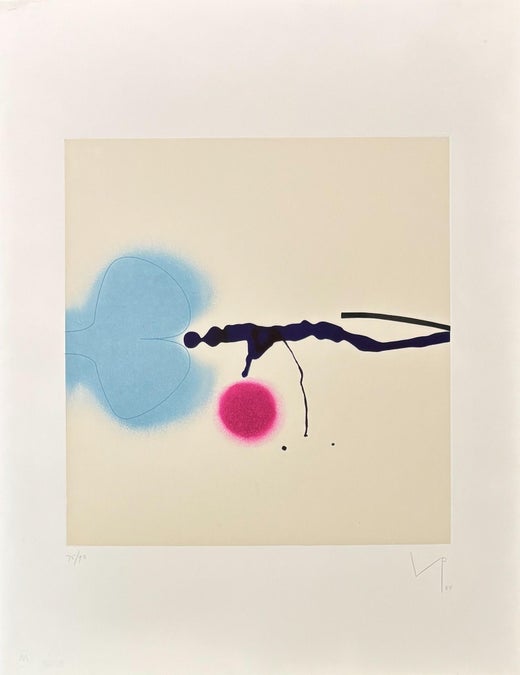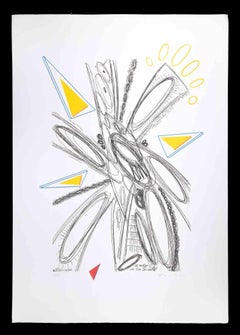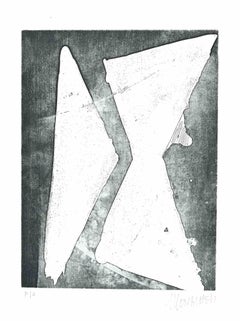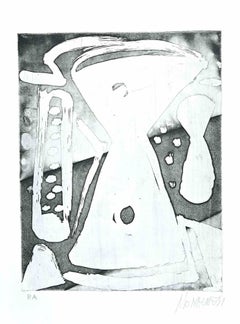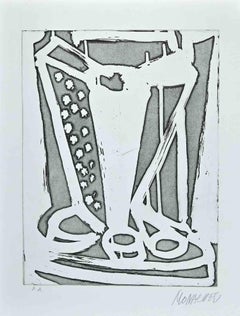Victor PasmoreThe Blue Between - Etching by Victor Pasmore - 19781978
1978
About the Item
- Creator:Victor Pasmore (1908 - 1998, British)
- Creation Year:1978
- Dimensions:Height: 21.26 in (54 cm)Width: 102.37 in (260 cm)Depth: 0.04 in (1 mm)
- Medium:
- Movement & Style:
- Period:
- Framing:Framing Options Available
- Condition:Insurance may be requested by customers as additional service, contact us for more information.
- Gallery Location:Roma, IT
- Reference Number:Seller: T-1398041stDibs: LU650312376732
Victor Pasmore
Victor Pasmore was born in Surrey, England. He was initially known as both a successful representational painter of still life and landscapes, who later became a pioneering abstract artist, producing collages, constructions, prints and paintings that were some of the most revolutionary works of their kind in Britain at the time.
Pasmore attended evening classes at Central School of Arts and Crafts beginning in 1927, while working as a local government officer, experimenting with art styles reflecting developments in art in France since the 1880s.
After experiments in lyrical abstraction in the early 1930s, Pasmore founded the Euston Road School with William Coldstream, Graham Bell and Claude Rogers in 1937, teaching a style of Cézannesque realism that he adhered to in his own portraits and landscapes. The school closed in 1940, but this group moved on to teach at the Camberwell School of Art 1943-49, though Pasmore himself began to experiment with abstraction again from 1947 onwards with the support of Kenneth Clark. His earliest new abstract experiments used linear forms and collage but in 1952 and in parallel with the work of Kenneth and Mary Martin, became rigorously constructivist, with some works as three-dimensional wall-reliefs in wood and perspex. Teaching at the Central School since 1949, he became Head of Painting at King’s College, Durham University in 1954, staying till 1961, when he was able to devote himself to painting full-time.
In the 1960s the geometry softened, introducing curved lines and edges, and bright colors blossoming in the 1970s and later into lyrical abstract compositions of points, wandering lines and planes of bright colors against his habitual white backgrounds and even some drawn outlines of natural forms again towards the end of Pasmore’s life. These transitions were inspired by his relocation to Malta in 1966, where he resided until his death. That same year, he also began intensive experimentation with making prints at the 2RC print shop in Rome in parallel with his paintings. Printmaking became a major part of his oeuvre and he worked with Curwen Press, Kelpra Studio, White Ink and other print studios. Since his death the popularity of his prints has escalated immensely, and his earlier work is now extremely rare.
Find original Victor Pasmore prints and other art today on 1stDibs.
You May Also Like
2010s Abstract Abstract Prints
Paper, Etching, Aquatint
Early 2000s Abstract Expressionist Abstract Prints
Etching
1990s Abstract Abstract Prints
Paper, Acrylic, Etching
Early 2000s Abstract Expressionist Abstract Prints
Paper, Etching
1970s Abstract Abstract Prints
Etching, Aquatint
Early 2000s Abstract Expressionist Abstract Prints
Etching
Jose Manuel BrotoIRIS 2. Limited edition Lyrical abstraction Spanish Contemporary Blue Strokes, 2006
1970s Abstract Abstract Prints
Paper, Etching, Aquatint
1960s Abstract Abstract Prints
Archival Paper, Engraving, Etching
1960s Abstract Abstract Prints
Etching, Aquatint
Mid-20th Century Abstract Expressionist Abstract Prints
Etching, Aquatint
More From This Seller
View All1970s Abstract Abstract Prints
Etching
1970s Abstract Abstract Prints
Etching
1970s Abstract Abstract Prints
Etching
1970s Abstract Abstract Prints
Etching
1970s Abstract Abstract Prints
Etching
1970s Abstract Abstract Prints
Etching
Recently Viewed
View AllRead More
Victor Pasmore’s Abstract Art Was Decades ahead of Its Time and Still Looks Radical Today
A new show of prints reveals just how much — and how indelibly — Pasmore revolutionized 20th-century British art.
5 Reasons to Collect Art
From discovering new mediums to supporting rising talents, there are many good motives for building a collection of meaningful works. Learn the hows and whys of art collecting with our guide.
